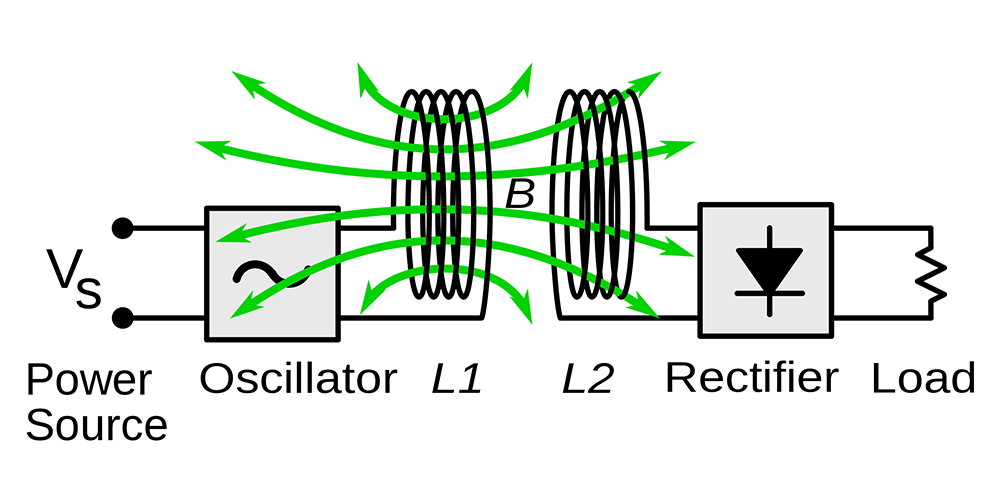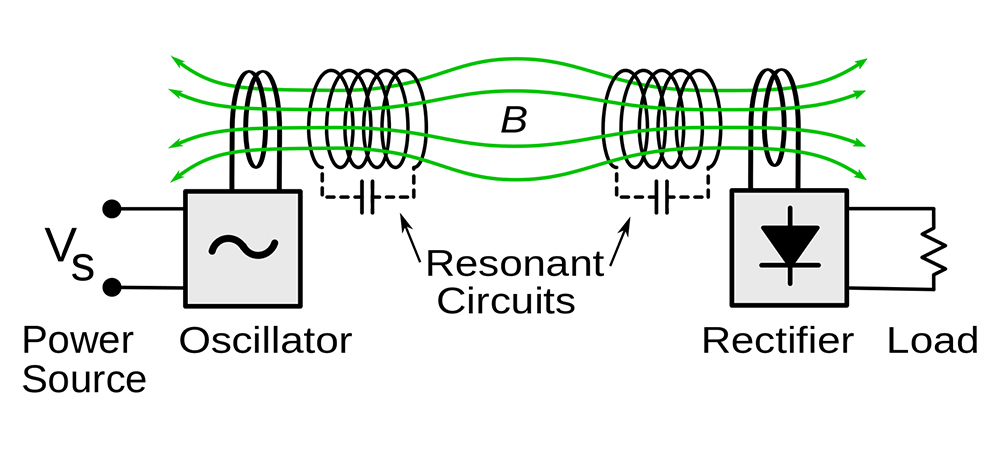
[ad_1]
Two essential forms of wi-fi energy switch methods are being pursued today: the inductive kind, which is magnetically coupled, and resonantly-coupled methods utilizing electromagnetic fields.
The moment availability of most torque makes driving even probably the most economy-oriented EV far more enjoyable than its ICE counterpart, however few would maintain the identical opinion concerning the refueling course of, particularly at quick cost stations with charging cables that rival a Burmese python in dimension. Wi-fi charging does put off wrangling these huge cables, however as common readers of those articles can most likely guess, there are some important trade-offs concerned. Nonetheless, it does seem that a lot of the points are being addressed, so maybe this would be the 12 months that wi-fi EV charging lastly hits the mainstream.
Wi-fi EV chargers are portrayed as cutting-edge expertise, however the MagneCharge system made by Hughes (a division of GM on the time) was commercially accessible on EVs manner again within the early Nineties . The MagneCharge system employed a paddle-shaped charging head which contained the first coil. This was inserted right into a mating slot on the automobile which contained the secondary coil. Although one nonetheless needed to bodily deal with a cable, energy was transferred throughout an air hole with none uncovered contacts, so this was very a lot a wi-fi charging system. Extra particularly, it was of the magnetically-coupled (aka inductive) kind, which is likely one of the two essential forms of wi-fi energy switch methods being pursued today (the opposite—to be mentioned in far more element under—makes use of resonant coupling).
An inductive wi-fi energy switch system consists of (at the very least) two coils of wire which might be often flat spirals in form and that are positioned in very shut proximity and in the identical airplane and axial orientation. An alternating present provided to a number of main coils generates a time-varying magnetic subject that induces an alternating present within the secondary coil. If that sounds suspiciously like a transformer to you, that’s as a result of it’s—the one distinction is that the first and secondary are bodily separated somewhat than wound on the identical core. It needs to be famous that minimizing the separation between main and secondary is a serious design driver in correct transformers because it maximizes the quantity of coupling between the 2 sides—ergo, the farther the 2 coils are aside, the decrease the quantity of energy that may be transferred between them. That is typically oversimplified as effectivity being inversely proportional to separation distance (air hole), and that isn’t completely unfaithful, however it’s extra correct to say that rising the air hole reduces the quantity of energy that may be transferred as a result of because the air hole will increase, extra of the magnetic subject traces from the first solely journey in a loop by way of the air again to itself, with out ever intersecting the secondary.
Because the separation between the coils will increase, extra of the vitality that may be transmitted by them as an alternative circulates between the facility supply and the first’s leakage inductance, doing no helpful work.
In transformer terminology, these orphaned loops of magnetic subject are referred to as leakage, they usually give rise to the dreaded leakage inductance, which is able to retailer vitality acquired from the supply solely to ship it again a quarter-cycle later (behaving very similar to a spring). In different phrases, because the separation between the coils will increase, extra of the vitality that may be transmitted by them as an alternative circulates between the facility supply and the first’s leakage inductance, doing no helpful work. If there have been no resistance current, then this circulating present would don’t have any impact on effectivity, however in the true (or sensible) world there are I2R losses incurred, therefore rising the separation distance does scale back effectivity. One factor to notice is that the purely magnetic fields of the inductively-coupled system (as in comparison with the electromagnetic fields utilized by the resonantly-coupled system) aren’t blocked by non-magnetic metals like aluminum, copper, and so on, however will induce currents in them, and that can decrease the general switch effectivity. The Hughes MagneCharge system apart, which operated at 6.6 kW (and had a really spectacular effectivity for its time of 80%), inductively-coupled wi-fi energy switch methods are sometimes used at decrease energy ranges and the place a low separation distance (lower than a number of mm) is straightforward to take care of, particularly when minimizing value is essential, for the reason that coupling mechanism actually is not any extra sophisticated than two coils which will be handled as an everyday transformer from the circuit’s perspective.

Determine 1: Block diagram of an inductive wi-fi energy system
The Hughes MagneCharge system did have some important security benefits over conductive charging interconnects similar to J1772, CHAdeMO, and so on, however it wasn’t far more handy to make use of, as you continue to needed to get out of the EV and bodily place the charging paddle right into a slotted receptacle on the EV to start out charging. Arguably not an enormous deal if the climate is sweet (or the charging station is inside a lined storage), however there’s no denying that merely having to park in a selected (however not too particular) spot then simply tapping a button on a cellphone app or the EV’s consumer interface to provoke charging can be way more handy. Such an association with an inductively-coupled system would require an virtually Rube Goldberg-like mechanical contraption to deliver the 2 coils shut sufficient collectively to impact energy switch with cheap effectivity, and to retract the EV-side coil far sufficient up within the undercarriage to have adequate floor clearance to outlive potholes, velocity bumps and the like whereas driving.
A system that didn’t require the facility transmitting and receiving coils to be introduced into such shut proximity (and that didn’t require such exact positional alignment of them, too) would make it in order that mounted coils may very well be used on the bottom and on the EV, and that’s the place the resonantly-coupled strategy begins to shine. It’s tolerant of a a lot bigger air hole between transmitter and receiver (over 100 occasions bigger—tens of cm will be accommodated), is much less choosy about alignment between the 2, and as a bonus, the magnetic subject from the transmitting coil will naturally be most drawn to the receiving coil, and can drop to a really low stage within the absence of a load on the receiving coil, somewhat than radiating off into free house in all instructions always, as is the case with the inductively-coupled strategy. What’s to not love about resonant coupling, then? Definitely loads—and extra on why under—however the primary points are that it’s far more advanced and much much less tolerant of variations in part worth. Regardless of that, resonant coupling nonetheless compares favorably to the mechanical contraptions wanted to accommodate inductive coupling at an analogous energy stage (on the premise that digital complexity is often less expensive to implement than mechanical).
Energy switch will happen utilizing simply the magnetic part of the electromagnetic subject, and little will probably be diverted into the electrical subject.
Energy switch within the resonantly-coupled system makes use of electromagnetic fields, the identical utilized by a microwave oven, a radio broadcast station, and so on, besides that the majority of the vitality is transported by the magnetic subject part, and the electrical subject is successfully out of the image. That is attainable as a result of the electrical and magnetic fields don’t come collectively to type a correct electromagnetic subject till they’ve traveled a ways from the antenna. Moreover, closed loops (like coils) are greatest at radiating magnetic fields, and are largely ineffective at radiating electrical fields (open wires or plates are greatest for that). Principally, then, so long as the transmitting and receiving coils of the resonantly-coupled system are positioned throughout the so-called close to subject—loosely outlined as a distance of 1/6 of a wavelength or much less, the place the wavelength, in meters, is fMHz / 300—energy switch will happen utilizing simply the magnetic part of the electromagnetic subject, and little will probably be diverted into the electrical subject. Whereas the circuitry concerned within the resonantly-coupled system is much extra advanced than that of its inductive counterpart, the transmitting/receiving coils won’t look that totally different. The primary distinction is that, within the resonant system, capacitors are added to every coil to type—no prizes for guessing accurately—resonant LC networks (or tanks within the argot) which is able to naturally oscillate at a frequency (in Hz) of 1 / (2 * Π * (L * C)^0.5) and have a attribute impedance of (L / C)^0.5.

Determine 2: Diagram of the WiTricity resonant inductive wi-fi energy system demonstrated by Marin Soljacic’s MIT crew in 2007
Assuming that each LC tanks have pretty related resonant frequencies (and the separation distance is throughout the close to subject), they may preferentially couple to one another somewhat than to free house, and can typically ignore different non-metallic objects (as with purely magnetic fields). This successfully leads to energy tunneling instantly from the transmitting LC tank to the receiving one within the resonantly-coupled system, somewhat than radiating off in all instructions, as can be the case with the electromagnetic fields of a standard RF wi-fi antenna system, or in large loops that observe the identical path whether or not a receiving coil is current or not, as is the case with the purely magnetic fields of the inductively-coupled system.
One other benefit of the resonantly-coupled system over the inductive one is that the LC tanks robotically convert any waveform thrown at them right into a pure sine wave, leading to a lot decrease noise emissions (learn: a far simpler time getting by way of EMC compliance testing). And simply as LC networks are used to carry out tender switching in energy converters, they’ll do the identical right here, vastly decreasing switching losses in each the downstream rectifier in addition to the upstream energy converter.
To date the resonantly-coupled system doesn’t appear that rather more sophisticated than the inductive one—simply add a capacitor throughout every energy switch coil and name it a day, proper?—however there are quite a few complications that come from resonant operation which may have you ever considering that the MagneCharge paddle wasn’t such a foul answer in any case. First, as already talked about, real-world inductors and capacitors are inclined to have a lot looser tolerances on worth, and each (however particularly capacitors with any form of dielectric in addition to air or vacuum) will drift in worth over time and temperature, so there must be some technique of robotically monitoring the precise resonant frequency of every tank. The standard answer here’s a phase-locked loop, or PLL, that tries to take care of a peak in sensed voltage (or present) within the LC tank by adjusting the driving frequency. Nevertheless, it’s vital that the frequency adjustment stay on one facet of the height, in any other case the management loop motion will invert (i.e. as the height worth decreases, the frequency adjusts to make it worse, somewhat than correcting it). Second, resonant LC tanks work greatest at a hard and fast energy stage (given by the loaded Q, or the ratio between the load resistance and tank attribute impedance), as various the heartbeat width on the driving facet does little to alter the facility throughput (a facet impact of the resonant LC community turning any waveform utilized to it right into a sine wave), so if the facility stage wants to alter, both the driving frequency has to alter or the driving pulses should be provided in bursts. Third, bringing the 2 LC tanks too shut collectively will paradoxically lead to them detuning one another! Principally, designing a resonantly-coupled wi-fi energy switch system that may be mass-reproduced—i.e. made into an actual product—is a Herculean feat, and that most likely explains why it’s taking so lengthy for such merchandise to hit the market, regardless of the extraordinarily alluring comfort they promise.
This text appeared in Concern 64: April-June 2023 – Subscribe now.
[ad_2]
